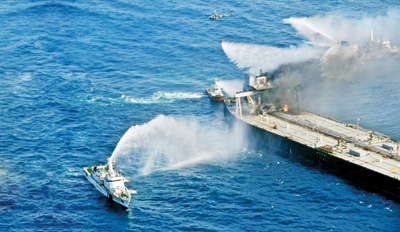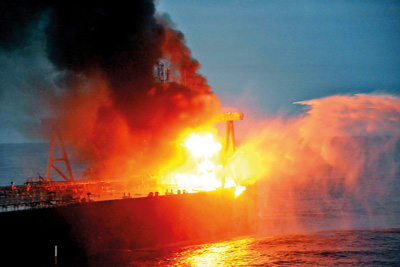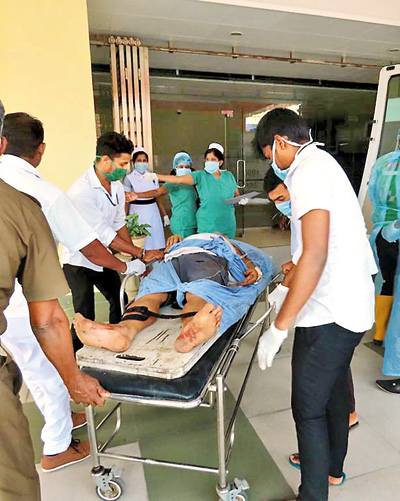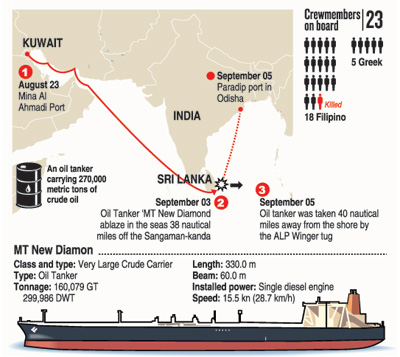News
Burning questions as fire onboard MT New Diamond simmers down

Both the Sri Lanka Navy and the Indian Coast Guard stated yesterday that the fire onboard had reduced
Though Sri Lanka is aiming to be a global maritime hub, this week’s fire onboard oil tanker MT New Diamond raises serious concerns over the country’s lack of preparedness to meet potential maritime disasters, industry experts said.
The stricken vessel, which was beginning to drift dangerously close to the island, was successfully towed to about 40 nautical miles (74 kilometres) off the Sri Lankan coast yesterday. The international effort to tow the oil tanker carrying 270, 000 Metric Tonnes of crude oil and bring the fire onboard under control involved vessels from the Sri Lankan and Indian navies as well as ships from the coast guard of the two countries, two tugs sent by the Hambantota International Port Group and two tugs sent by the salvage company hired by the ship’s owners.
Meanwhile, the Indian Coast Guard tweeted on Friday (4) that it deployed two Dornier aircraft with pollution response spray pods and oil spill dispersants to Mattalla International Airport as a preventive measure towards oil spill contingency. The aircraft, together with their specially trained crew, are currently on standby at the Mattala airport.
Both the Sri Lanka Navy and the Indian Coast Guard stated yesterday that the fire onboard had reduced.
Nevertheless, the incident raises serious concerns. Sri Lanka’s preparedness for emergencies on its sea routes was far behind where it should be, noted Ikram Kuttilan, Chairman of the Ceylon Association of Shipping Agents.
“Sri Lanka’s close proximity to key sea lanes is common knowledge,” he said as he expounded on the areas of development required in order to become the maritime hub that Sri Lanka aims to be.

A ball of fire: The scene on deck on Thursday when the fire broke out
The tugs that are available in Sri Lanka are only suitable for berthing ships. “It’s important to invest in better tugs that can be useful during emergencies and even for things like towing,” he said. Mr.Kuttilan also noted that facilities for the containment of oil spills were also a need of the hour. “We have ‘booms’ that can only be used to contain a spill around the immediate ship, but this is not sufficient for the containment of a major spill.” A boom is a plastic contraption that is generally used to reduce the spread and consequent destruction of marine resources as a result of oil spills. Booms concentrate oil in thicker surface layers so that skimmers, vacuums, or other collection methods can be used more effectively. “Sri Lanka’s ‘boom’ resources are very limited and insufficient for the handling of a spill like the one we just avoided,” he said.
He also added that the next part of the emergency response would include facilities to vacuum the oil into a barge for transportation and the spraying of chemicals to nullify the oil remnants to avoid contamination.
He noted that it was very fortunate that the authorities were able to utilize the resources they had to control the situation. “It didn’t affect the cargo which would’ve been catastrophic.” He noted that authorities like the Marine Environment Protection Authority (MEPA), and the Sri Lanka Ports Authority needed to invest in expertise and encourage private sector investments into resources of this nature. “It won’t be a free service that the private sector provides as insurance claims and compensation is provided for the use of these,” he said.
Sri Lanka was currently “very poorly equipped and unprepared” to fight disasters of this nature, said Dr Hiran Jayawardene, founder and former Chairman of the National Aquatic Resources Research and Development Agency (NARA). “It is not the fire we have to worry about but the physical impact on the marine environment, beaches and ecosystems,” he pointed out, adding that any oil spill will choke off everything it comes in contact with, including reefs and beaches.
A former harbourmaster that wished to remain anonymous also noted that Sri Lanka was nowhere near to where it should be in terms of resource management.

A crew member being wheeled into Kalmunai Base hospital. Pic by Lakshman Deva
If an oil spill were to occur, a total of 2500 metres of booms would have been required to lay around the 330 meter ship. Sri Lanka is bound to have a maximum of 1500 booms across the entire country, according to the harbormaster. “Without oil skimming resources or tugs that are big enough, it’s no surprise that the Indian Coastguard had to get involved,” he said.
He noted that the private sector has since invested in equipment purchases from Singapore to prepare for future events. “If the oil spilled and polluted the many lagoons on the east coast we would’ve had to say goodbye to our tourism for the next 10 years while we cleaned it up,” he said. This damage would be apart from the destruction of the livelihoods of thousands of people that depend on the lagoons.
While a major ecological disaster may have been averted, the incident was “an eye-opener” for Sri Lanka and the region, acknowledged MEPA Chairperson Dharshani Lahandapura.
She added that they have already identified several weaknesses that constrained the agency, including within the Marine Pollution Prevention Act, which needed to be amended.
At a press conference on Friday, Ms Lahandapura said the resources MEPA had to deal with a potential disaster of this nature were “negligible.” She however, told the Sunday Times that the Government has now essentially given MEPA a blank cheque to purchase whatever material it required to counter any potential threat from such a spill.
Ms Lahandapura said the incident management team set up just after the incident was reported on Thursday has been busy working with various stakeholders to draft a plan to counter any threat from an oil spill if it were to occur. “We have identified the area extending from Hambantota to Ampara as being vulnerable to any oil spill from the vessel. Obviously, we cannot cover all areas on the coast. As such, we have designated specific areas as high, medium and low risk areas.” 
The areas have been designated as per the severity of the risk, the ecological sensitivity of the area and the probability of an oil spill affecting them, the MEPA chairperson said, adding that these areas are being assigned to various stakeholders so specific agencies will be responsible for a designated area.
All equipment belonging to MEPA and other stakeholders that can be used to counter a potential spill are now stationed in Kirinda, Hambantota and Trincomlaee to be deployed immediately in the event of a disaster.
No one country can handle such a disaster alone, however well it prepares, Ms Lahandapura stressed. “We also need to strengthen regional cooperation and capacity,” she insisted.
| Met Dept. teams up with India’s ocean info centre to chart oil spillage drift patterns | |
|
By Nadia Fazlulhaq The Meteorology Department has been receiving hypothetical oil drift patterns from an ocean information service centre in India to be in readiness for a worst case scenario in case of spillage from the distressed vessel carrying 270,000 metric tonnes of crude oil and 1,700 tons of diesel oil. On a request from the Met Department, a hypothetical oil drift simulation is being carried out by the Indian National Centre for Ocean Information Services’s (INCOIS) coming under the Indian government’s Ministry of Earth Sciences. It is being done, using an oil spill model. Deputy Director Meril Mendis said the Met Department had been sending INCOIS details of the vessels position and using the data, the Indian Centre determined the hypo spill start date/time and oil spill model run duration. INCOIS oil spill trajectory maps show the directions of the the oil drift pattern. Through the department’s Natural Hazards Early Warning Centre, the information is then shared with Sri Lanka Navy the Disaster Management Centre and the fisheries authorities, he said. “Sri Lanka has no modelling capabilities to determine a possible oil spill and its directions based on ocean patterns. Therefore we are constantly in touch with the Indian authorities who are providing assistance free of charge,” he said. According to the later oil drift advisory, the simulations based on hypothetical spill indicates that Sri Lanka’s coast is not under threat of being affected by oil pollutants until 11pm on Monday, provided there is no change in vessel position. The oil drift pattern will be forecast in periodic intervals with updated vessel position and different spill start timings. |
| New Diamond owner wanted ship to be harboured in Trinco | |
| The Greek owner of the MT New Diamond vessel initially planned to harbour the ship in distress at the Trincomalee harbour, said Ranjan Perera, Lanka representative for the International Transport Federation.The crude oil tanker is owned by Porto Emporios Shipping Inc., New Shipping Limited based in Greece. Among the crew members five including the Captain are Greeks. “I telephoned the owner when the fire erupted. He said once the fire is fully under control the ship will be brought to the Trincomalee harbour. But now there are doubts as the engine is damaged and our government will be reluctant to drag it back to its shores when there is a potential oil spill,” said Mr. Perera. He said that it will take two to three weeks to completely control the situation and cool down the engine. “Most probably the assistance of Indian Oil Company tankers will be sought to move the oil away from the damaged tanker. Moving crude oil is a difficult task,” he said. |
| Moves to seek release of Lankan officer held over oil leak off Mauritius | |
| The Sri Lanka office of the International Transport Federation (ITF) is to obtain the Foreign Relations Ministry’s assistance to approach the Mauritius government to release the Lankan Chief Officer presently arrested over the major oil spill that occurred in July.Japanese oil tanker MV Wakashio crashed into a reef in Mauritius setting off a leak of more than 1,000 tonnes of oil to the coral reef surrounding the island-nation. Both the Indian Captain and the Lankan second in command Tilak Suboda were arrested under the country’s Piracy and Maritime Violence Act. It was reported that the ship was brought towards the shore from mid sea to have a party. “We are taking action to release the Sri Lankan national being detained by the Mauritius government. The support of the embassy there is also sought. The Indian government is taking all measures to get the Indian national released,” Ranjan Perera, ITF’s Lankan representative said. |
|
President thanks defence forces of India and Lanka President Gotabaya Rajapaksa yesterday thanked Sri Lankan and Indian defence forces for their efforts in controlling the fires aboard oil tanker MT New Diamond. “Thank you! to the #SLNavy , the #SLAirforce, the #SLPA and the Indian Defence Forces for their efforts in controlling the fires in MT New Diamond. I greatly appreciate your contribution in conserving marine biodiversity by preventing a disastrous situation out in the ocean,” the President said in a Twitter message. Meanwhile, in a twitter message, Indian Oil Corporation (IOC) Chairman Shrikant Madhav Vaidya also hailed the “valiant efforts” of the Indian Navy, Indian Coast Guard, Indian Air Force and the Sri Lanka Navy. The New Diamond had been chartered by IOC and had been on its way to the Indian port of Paradip, where the state-run IOC runs a 300,000 barrel-per-day refinery.
| |

